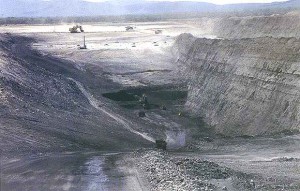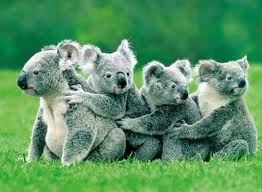Koalas: The Canary in Australia’s Coal Mine?
May 8th, 2013 | By admin | Category: Environment/SustainabilityBy Suzanne York, www.howmany.org
The news of late out of Australia has not been the most encouraging.
For starters, the country continues to mine coal at a rapid pace, upping its exports of the dirty fuel. It is the world’s biggest coal exporter. A recent report found that if the expected expansions of Australia’s coal exports continue as planned, global carbon dioxide emissions could increase by 1.2 billion metric tons a year.
Also on the rise is population, where the land down under is experiencing a 1.7% annual growth rate, which is high for a developed nation. The current population stands at 23 million; though much less than say the state of California’s 38 million citizens, the rate of growth is a cause of concern for many wanting a sustainable population and healthy communities.
And one last news item of note has been the worsening plight of koalas, the unofficial symbol of Australia. Climate change is amongst the many concerns facing the marsupials, where more occurrences of extremes in weather pose a threat to the koala population.
Business as Usual
The above issues are all related. Increasing numbers of people rely on electricity and fuel in their daily lives, depending upon finite resources such as coal and oil. Citizens migrate in search of livelihoods and a better life. And more people using more resources usually results in more species losing habitat or being killed for one reason or another. For Australians, koalas could be their canary in the coal mine.
Modern society continues with business as usual, disregarding the risks to people and the natural environment. Koalas are loved by many the world over, yet they are in real danger of being wiped out in the wild. They are not alone. Humans are doing a pretty good job of poaching elephants, rhinos, and tigers out of existence as well.
We Have the Answers
What is frustrating is that we know what to do to make things better. Coal is a finite and polluting fossil fuel that should be phased out and replaced with clean energy options. Australia is certainly ripe for solar power. And the Australian government passed a carbon tax in 2012, which can help in the shift to renewable energy.
Population growth globally should be stabilized by lifting people out of poverty and by empowering women through providing voluntary family planning services, education, and sustainable livelihoods. As for Australia specifically, much of its growth is taking place in western Australia, such as Perth, a water-scarce city, where its underground aquifer is being overpumped due to rising demand. Water conservation and efficiency measures can help, and also people choosing to live where water isn’t as scarce.
The increasing number of people in Australia affects the ecosystem. There may be only 45,000 to 90,000 koalas left in the wild. Koala habitat continues to be destroyed by logging, agriculture, mining, and urban development, and dogs and disease are other major threats. Koalas should be listed as an endangered species. And this should be taken at least a couple of steps further. One step is passing a Koala Protection Act, as urged by the Australian Koala Foundation. This is similar to the legislation that protected the American bald eagle, another national icon that was severely threatened until greater protections were implemented.
A second step to help koalas and other species is supporting rights of nature. This concept recognizes that nature is not simply property for humans to use and abuse. Rather, ecosystems (including trees, oceans, animals, mountains), have rights just as human beings have rights.
The Big Rethink
Until society as a whole rethinks growth – especially economic growth – and learns how to live sustainably and within its means, koalas and many other creatures could disappear from the wild. The world can act now and reverse course, and consider the rights of nature and future generations. Or global society can continue on this path and hope for the best, which may or may not include some of Earth’s most popular creatures.


